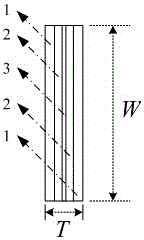Planar waveguide laser gain medium configuration for inhibiting ASEPO
A technology of laser gain and planar waveguide, which is applied to lasers, laser components, active dielectric materials, etc., can solve problems such as beam quality degradation, limitation of maximum output power, and difficulty in achieving miniaturization
- Summary
- Abstract
- Description
- Claims
- Application Information
AI Technical Summary
Problems solved by technology
Method used
Image
Examples
Embodiment
[0025] Nd:YAG planar waveguide configuration, the core layer is Nd:YAG, the doping concentration is 0.5at.%-1.5at.%, the core layer thickness d is 80μm-200μm, the inner cladding is non-doped YAG, the whole waveguide The size is 50mm(L)×10mm(W)×1mm(T). The two end faces of 10mm×1mm are laser passing surfaces, the angle between one end face and the 60mm×10mm large face is 90°, and the angle between the other end face and the 60mm×10mm large face is 75-88°, and both end faces are Coated with a 1064nm high-transparency film.
[0026] Using the above Nd:YAG planar waveguide configuration, a planar waveguide laser amplifier is built. The laser works in quasi-continuous mode, the wavelength of the pump source is 808nm, when the pulse repetition frequency is 100Hz, the single pulse output energy is greater than 500mJ, and the light-to-light conversion efficiency is 50%.
[0027] Experiments show that the planar waveguide gain medium configuration can suppress ASE / PO very well and re...
PUM
 Login to View More
Login to View More Abstract
Description
Claims
Application Information
 Login to View More
Login to View More - R&D
- Intellectual Property
- Life Sciences
- Materials
- Tech Scout
- Unparalleled Data Quality
- Higher Quality Content
- 60% Fewer Hallucinations
Browse by: Latest US Patents, China's latest patents, Technical Efficacy Thesaurus, Application Domain, Technology Topic, Popular Technical Reports.
© 2025 PatSnap. All rights reserved.Legal|Privacy policy|Modern Slavery Act Transparency Statement|Sitemap|About US| Contact US: help@patsnap.com



